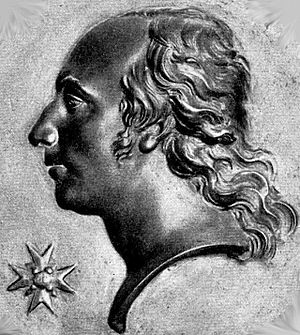Rudolf Cederström facts for kids
Quick facts for kids
Rudolf Cederström
|
|
|---|---|
 |
|
| Birth name | Olof Rudolf Cederström |
| Born | 8 February 1764 Landskrona, Sweden |
| Died | 1 June 1833 (aged 69) Funbo village, Sweden |
| Allegiance | Sweden |
| Service/ |
Swedish Navy |
| Years of service | 1779–1828 |
| Rank | General admiral |
| Battles/wars | Russo-Swedish War (1788–90)
|
Olof Rudolf Cederström (born February 8, 1764 – died June 1, 1833) was a brave Swedish naval commander. He joined the Swedish navy in 1779. As a captain, he led a successful attack on Rogervik. He became famous in 1790 for his actions in the naval Battle of Reval and the Battle of Viborg Bay.
Later, he commanded ships that fought against privateers (private ships allowed to attack enemy ships) in the North Sea. In 1801, he sailed to the Mediterranean to help the United States Navy during the First Barbary War. In 1808, his ships helped protect Gotland from a Russian invasion. His last military mission was in 1813, when he helped Swedish forces capture Vorpommern from Denmark and France. He served as a minister for a short time but returned to the navy in 1818. He retired in 1828.
Contents
Rudolf Cederström was born on February 8, 1764, in Landskrona, Sweden. His parents were Claes Cederström and Margareta Elisabet von Mevius. He studied in Uppsala in 1776. In 1779, he officially joined the navy's admiralty.
He quickly moved up the ranks. By 1781, he was a second lieutenant. In 1784, he worked as a harbourmaster in Saint Barthélemy. He became a sub-lieutenant in 1785 and a lieutenant in 1788.
Heroic Actions in War
Rudolf Cederström showed great courage during the Russo-Swedish War (1788–1790). On March 17, 1790, he led a small group of ships to Rogervik. There, they successfully destroyed important timber and military supplies belonging to the Russian fleet. For this brave act, he was promoted to major.
He also played a key role in two major naval battles that year. He fought bravely in the Battle of Reval on May 13, 1790. Later, he distinguished himself again in the Battle of Vyborg Bay on July 4, 1790.
Protecting Trade and Fighting Pirates
After the war, Cederström continued to rise in the navy. In 1793, he became a lieutenant colonel. He was promoted to colonel in 1795. In 1796 and 1798, he commanded a group of frigates (a type of warship) in the North Sea. His mission was to protect trade ships from privateers, who were like legal pirates.
In 1801, he became a rear admiral. He was sent with a squadron to the Mediterranean Sea. His important task was to stop the Tripolitanian pirates who were attacking ships. After 20 months, he successfully made peace with Tripoli.
Defending Sweden's Coasts
In 1808, Cederström took command of a squadron. Their job was to protect the Swedish coast from a possible attack by French and Danish forces. That same year, Russia took control of the island of Gotland. Cederström led a Swedish expedition from Karlskrona to remove the Russian forces. They succeeded in just three days.
After this, Cederström was made vice governor of Gotland. He helped set up the Gotland National Conscription, which was a way to organize the island's defense.
Later Career and Retirement
Cederström was promoted to vice admiral in 1809. He served as the military commander of Gotland from 1810 to 1811. In 1813, he became the general commander of all Swedish naval forces fighting against Denmark and France. For a short time in 1814, he also commanded naval forces against Norway.
He became a minister in the government in 1815. In 1816, he was appointed Governor of Stockholm. He was promoted to admiral in 1818. He received the title of Count in 1819 and became a Lord of the Realm in 1821. In 1823, he was promoted to general admiral. He also became the commanding officer of the Royal Majesty's Fleet. This new fleet was created by combining two older fleets based on Cederström's ideas.
However, during his time leading the fleet, he faced criticism from parliament and the press. There were questions about some financial dealings involving warships. This led to his resignation in 1828, ending his long and impressive career.
Family Life
Rudolf Cederström married Countess Charlotta Catharina Wrangel af Sauss on February 16, 1793, in Karlskrona. They had several children:
- Claes Anton (born 1795)
- Margareta-Charlotta (1796–1883)
- Gustaf Adolf (born 1797)
- Olof Rudolf (born 1800)
- Carl-Emanuel (born 1804)
- Fredrik Ture (born 1808)
In his later years, he lived on his estate called Lövsta in Uppland County. Rudolf Cederström passed away there on June 1, 1833.
Awards and Honors
Rudolf Cederström received many awards and honors throughout his career, showing his dedication and bravery.
Awards and Decorations
- Order of Charles XIII (1825)
- Knight and Commander of the Orders of His Majesty the King (1816)
- Knight Grand Cross 2nd Class of the Order of the Sword (1814)
- Commander Grand Cross of the Order of the Sword (1803)
- Commander of the Order of the Sword (1799)
- Knight of the Order of the Sword (1790)
Honors
- Honorary member of the Royal Swedish Academy of War Sciences (1809)
- Honorary member of the Uppsala County Agricultural Society (1829)







